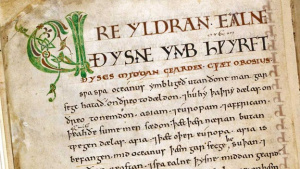Language/Old-english-ca-450-1100/Grammar/Adjectives
Hi Old English (ca. 450-1100) learners! 😊
In this lesson, we will dive into the fascinating world of Old English (ca. 450-1100) adjectives. We will learn about their forms, their functions, and how to use them in context. By the end of this lesson, you will be able to express yourself more accurately and with greater nuance using adjectives.
Once you've mastered this lesson, take a look at these related pages: Pronouns, Questions & Gender.
What are adjectives?[edit | edit source]
Adjectives are words that describe or modify nouns or pronouns. They are often used to provide more information about a noun, such as its size, color, shape, or other qualities.
In Old English (ca. 450-1100), adjectives had different forms depending on the case, gender, and number of the noun they modified. This meant that the adjective had to agree with the noun in these categories. For example, if the noun was feminine, the adjective had to be in the feminine form as well. If the noun was plural, the adjective had to be in the plural form.
Adjective Forms[edit | edit source]
Old English (ca. 450-1100) adjectives had two types of forms: the strong form and the weak form. The strong form was used when there was no accompanying article, while the weak form was used when there was an accompanying article.
However, there were some exceptions and irregularities in the declension of adjectives.
Using Adjectives[edit | edit source]
Adjectives can be used in a variety of ways in Old English (ca. 450-1100). They can be used attributively, predicatively, and adverbially.
When an adjective is used attributively, it directly modifies a noun and provides more information about it. For example:
- stǣnen hofu (stonen hoof) - a stone hoof
When an adjective is used predicatively, it is used as part of a sentence to describe a noun or pronoun. For example:
- Hēo wæs brūn (She was brown)
Adjectives can also be used adverbially, which means they modify a verb or an adjective. For example:
- Sē stān wæs swīðe stǣnen (The stone was very stony)
Dialogue[edit | edit source]
Person 1: Hwæt sind ēower frēond? (What are your friends?) (Person 1: hwat sind ayower freond?) Person 2: Mīn frēond sind gōde (My friends are good) (Person 2: meen freond sind gode)
Cultural Tidbit[edit | edit source]
Did you know that Old English (ca. 450-1100) was the language spoken by the Anglo-Saxons, a group of Germanic tribes that invaded England in the 5th and 6th centuries? They brought their language, culture, and traditions with them, which had a lasting impact on English language and literature as we know it today. Old English (ca. 450-1100) was the language of the epic poem Beowulf, which is one of the oldest surviving poems in English literature.
To improve your Old English (ca. 450-1100) Grammar, you can also use the Polyglot Club website. Find native speakers and ask them any questions!
➡ If you have any questions, please ask them in the comments section below.
➡ Feel free to edit this wiki page if you think it can be improved. 😎
Other Lessons[edit | edit source]

